Escape from the city
Sydney is truly one of the great cities of the world – a world class harbour, stunning coastline, iconic buildings, rich history and sparkling weather. There’s no doubt Sydney has it all. But that being said, after months of self-isolation, social distancing and tedious boredom it was fantastic to pack up our new truck/camper, the recently arrived Wanda, and head out north or west or south or wherever we wanted to go. And we had quite a long list.
New South Wales, as we are learning again this year, is a wonderful playground for those willing to get off the beaten track and sleep in quiet places. Our high-level plan, subject to change, was to spend about a month doing a broad counter-clockwise boundary fence tour of the state’s borders, exploring everything we could along the way. That means heading north as we wander from national park to national park before turning west into Australia’s outback until we run out of space again, then turning south down to the Murray River which marks the border with Victoria and then east again back to home sweet home. Or something like that.
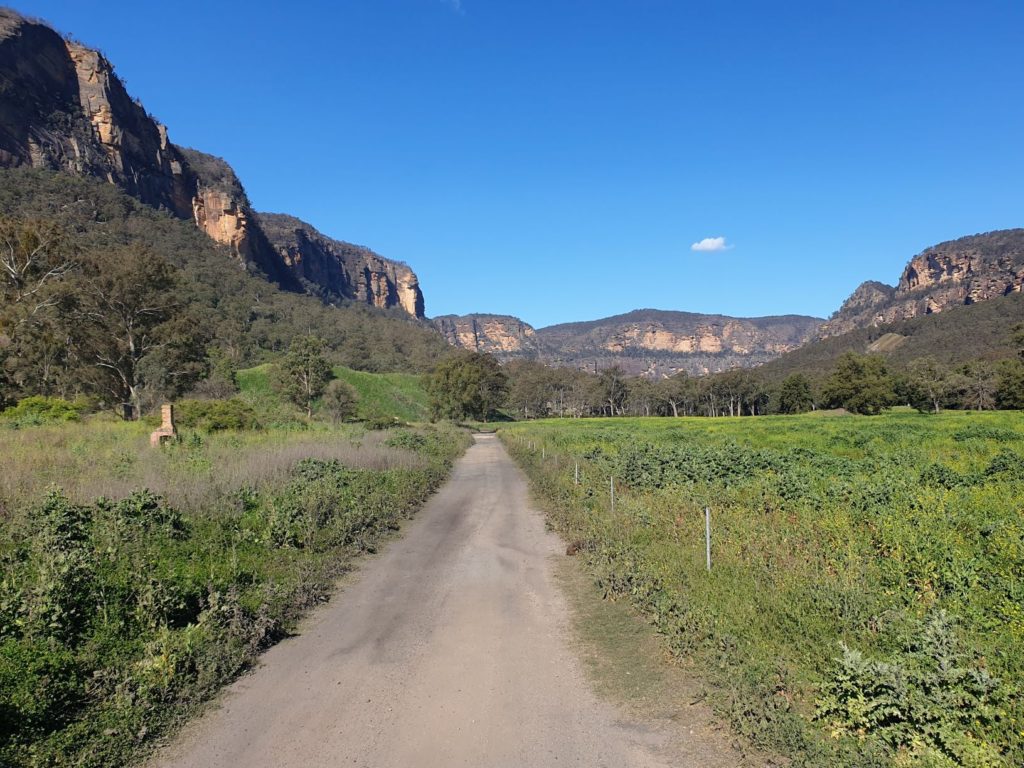
The magnificent Capertee Valley closes its high escarpment walls behind the old mining town of Glen Davis – and this was the setting for our first night
There are national parks everywhere in New South Wales and some provide rich rewards for those willing to bounce along dirt tracks and get away from it all. We camped one night under the escarpment walls of Wollemi National Park behind the old shale oil mining town of Glen Davis and took off our shoes as we walked along the sandy bottom of the Capertee River.
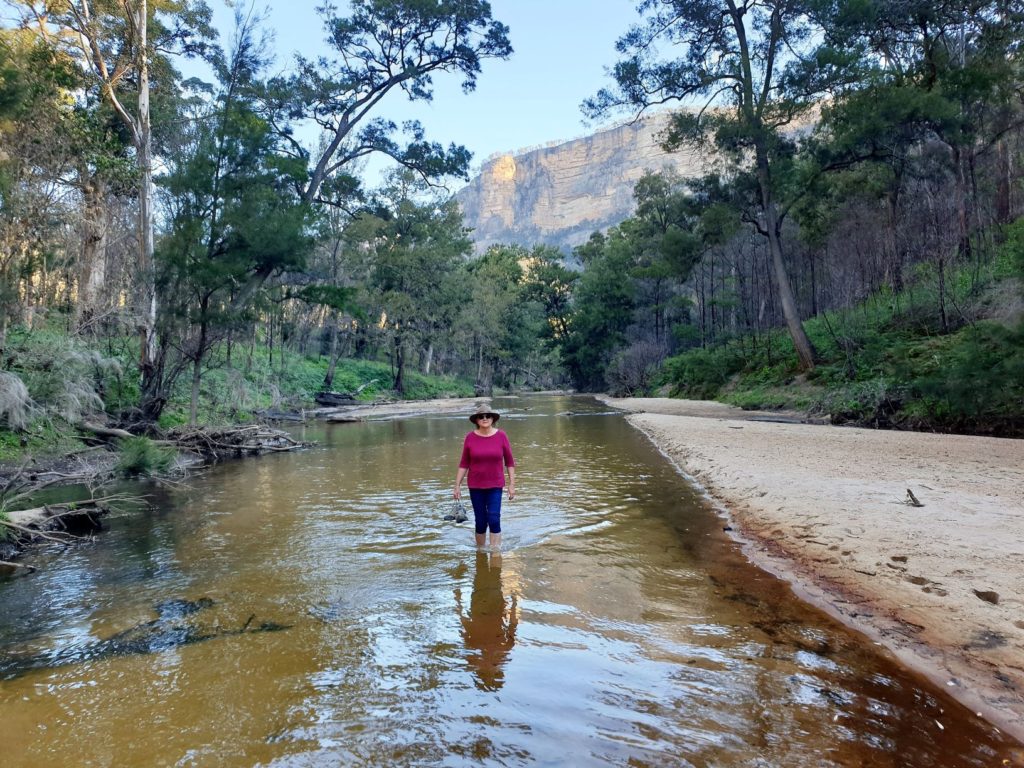
We took off our shoes and enjoyed a beaut walk in the sandy Capertee River with the high escarpment walls all around us
We then met up with Julie’s sister Jacinta and her husband Andrew in Coolah Tops National Park where we camped for two nights and explored the many beautiful corners of this preserved land. In Coolah Tops, which sits at about 1,000 metres, we were lucky to spot red necked wallabies in addition to being visited in both our camps by eastern grey kangaroos, plus a variety of great birds, including the rainbow-coloured eastern rosellas.
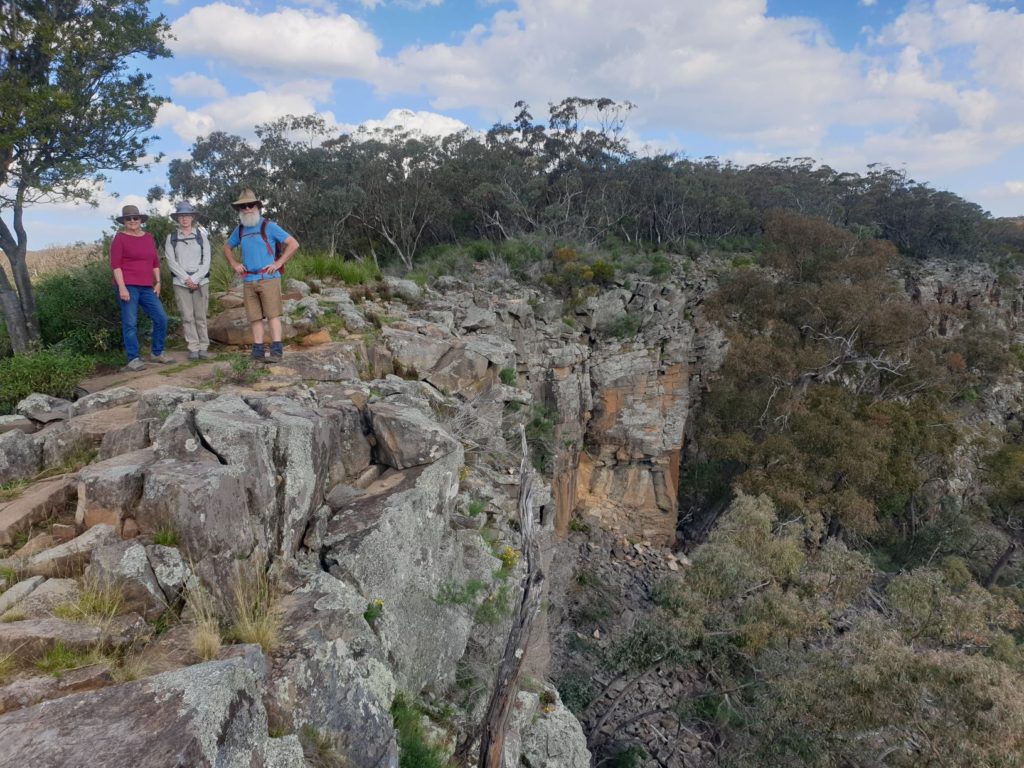
Coolah Tops NP provided a great variety of places to go, including this cool walk with Andrew and Jacinta out to a point on the escarpment
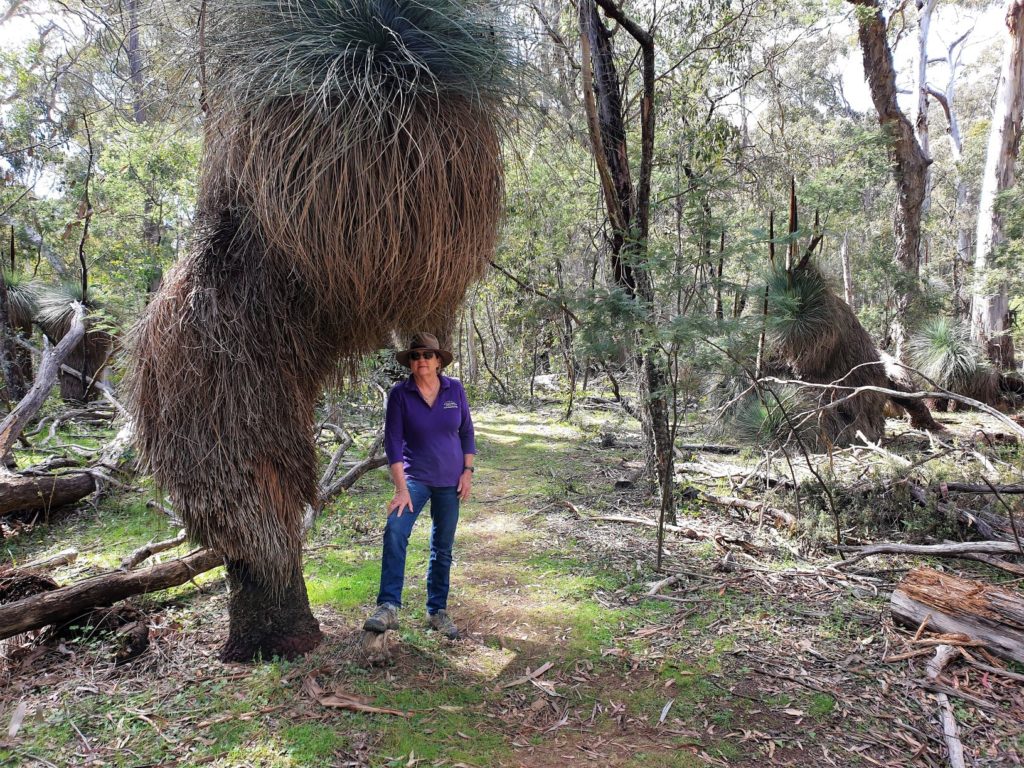
Coolah Tops is known for its spectacular trees, including a grove of very old and impressive grass trees
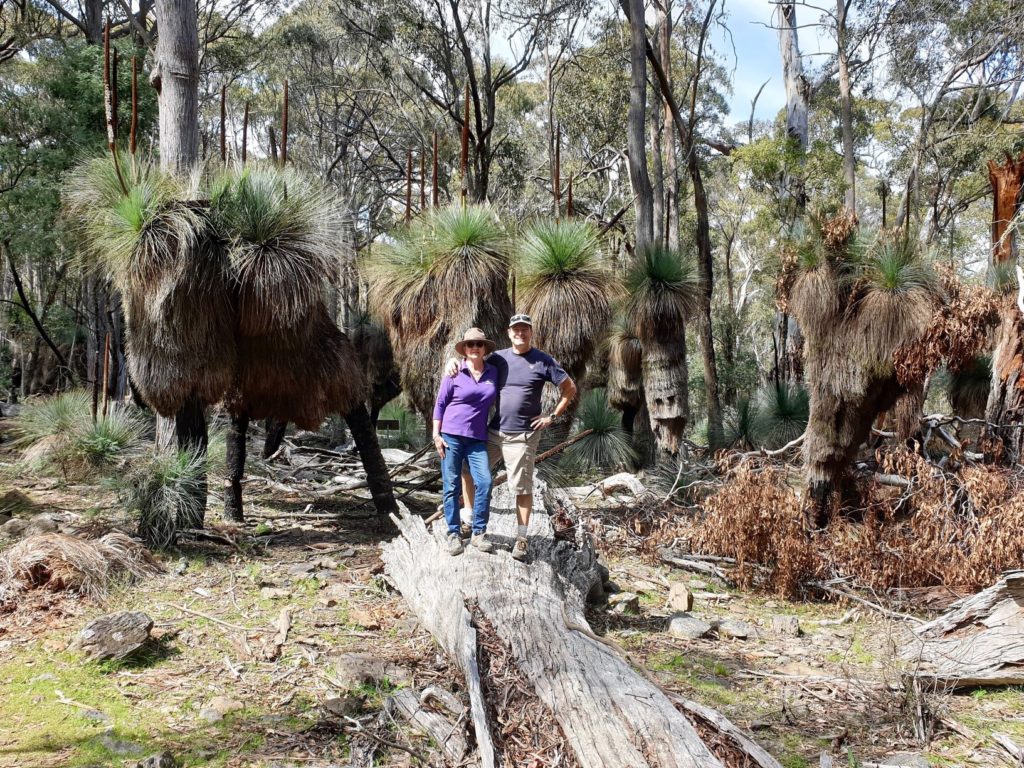
Julie and I standing in front of some of these great grass trees, some of them a couple centuries old
But above all else, Coolah Tops is overwhelmed with trees, a fabulous variety of trees. We drove and walked amongst thick forests of stringy barks, for which the area was logged in the last century, walked amongst a fascinating grove of ancient grass trees, some many hundreds of years old, crammed our necks for stately ribbon gums, camped under a forests of pines planted over a hundred years ago and strolled through beautiful tall snow gums which can reach 40 metres and add grace and statue to the forest. Coolah Tops is all about the trees and deservedly so.
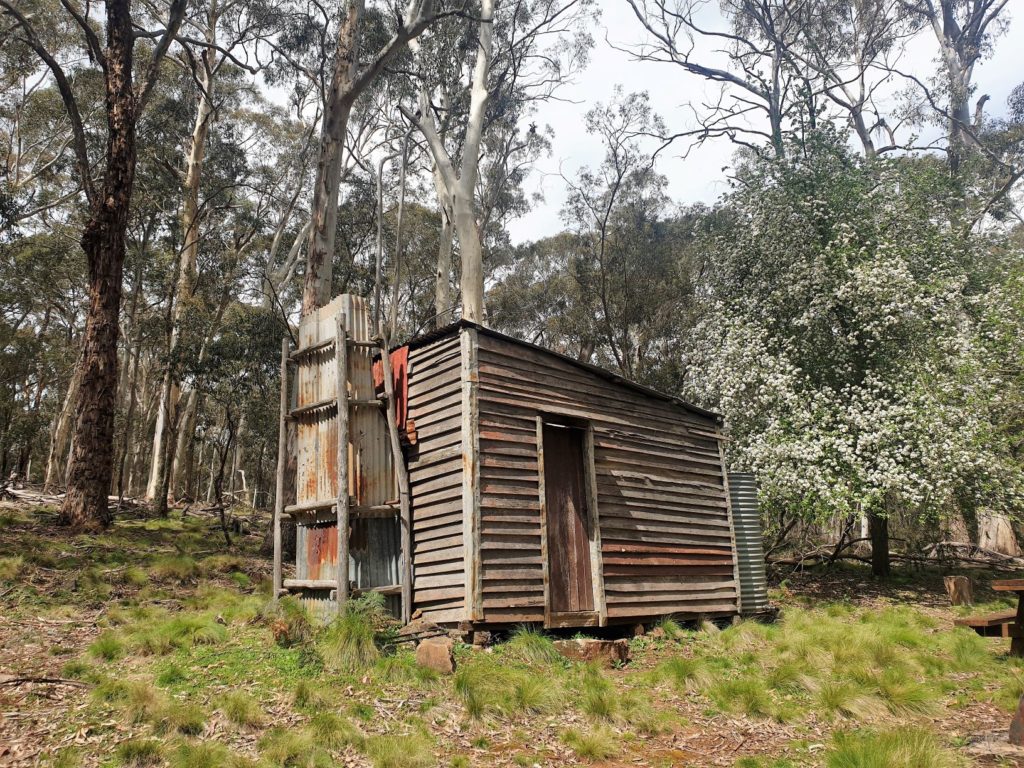
Coolah Tops was heavily logged about 100 years ago and these little loggers huts are sometimes found amongst the gum trees
For Julie and I, our goal the next day was the Pilliga Forest north of the delightfully-named Coonabarabran but to get there we took the back roads…or in this case, the back dirt roads used primarily by the graziers and farmers who squeeze a living out of this rich but harsh land. Through beautiful rolling hills we went up and over the Pandora Pass and down into the pathetically-named Liverpool Plains which features grazing land as far as the eyes can see.
Our map showed the obscure Tinkrameanah National Park, which was reported to have no tourist facilities, development or purpose other than to preserve native forests. We asked an old grazier if there was a way to get to the park around or through private land and sure enough, he gave us exact directions along an obscure track. There we were, following an overgrown sandy track through this preserved land, perhaps the first visitors in weeks. A perfect spot for lunch.
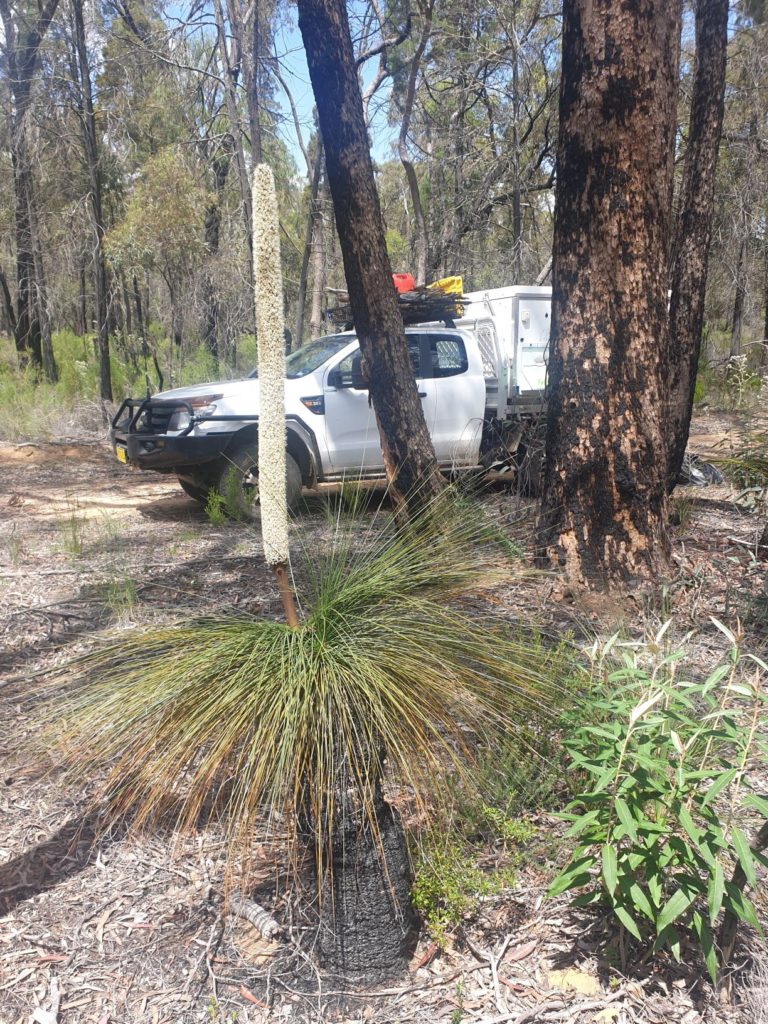
A different kind of grass tree, this one much shorter but sporting a beautiful budding flower, joined us for lunch in Tinkrameanah National Park
On to Coonabarabran where we picked up supplies, fuel and showers at the local caravan park, then north into the Pilliga Forest and eventually into Timmallallie National Park – as if you’ve ever heard of it – and enjoyed the three kilometre walk along the edge and into the river bed of Dandry Gorge. This lovely late afternoon walk featured dozens of different beautiful flowers and the unique Sculptures in the Scrub where local artists created sculptures that celebrate the local indigenous culture. We camped nearby all by ourselves, our Covid safe distance to other people probably something like 30 kilometres.
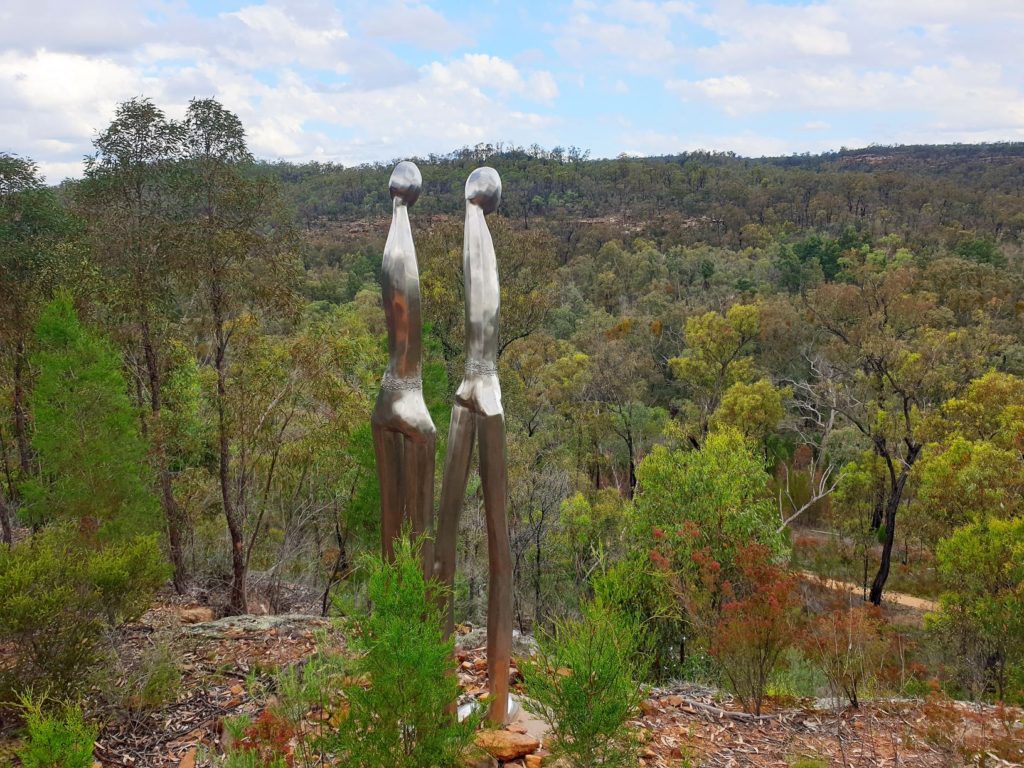
We followed the trail along the edge of the Dandry Gorge and enjoyed the unusual Sculptures in the Scrub, including these two characters admiring the views
But the vast area known as the Pilliga, comprising multiple national parks, state forests, nature preserves and state conservation areas had much more to give. We stopped at the salt caves where local indigenous people and more recent settlers have extracted valuable salt from the caves and also climbed the lookout tower, once used to keep an eye out for fires in this vast wooded area.
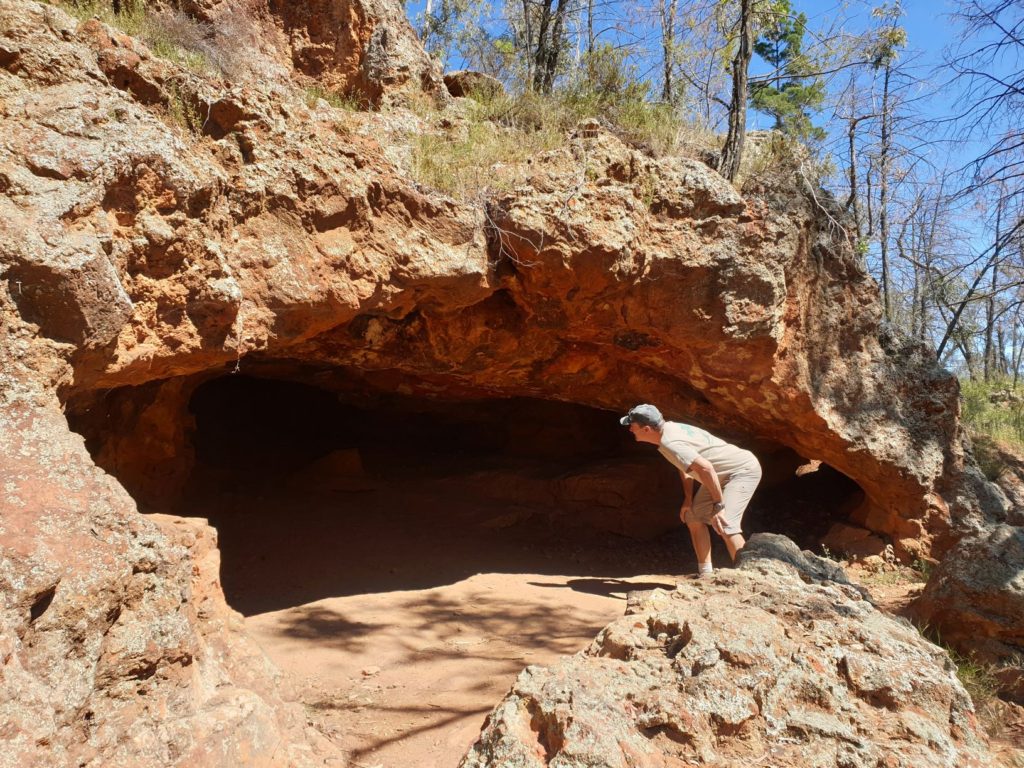
You want me to go in there? Caves in the middle of the forest were the source of salt for locals for thousands of years.
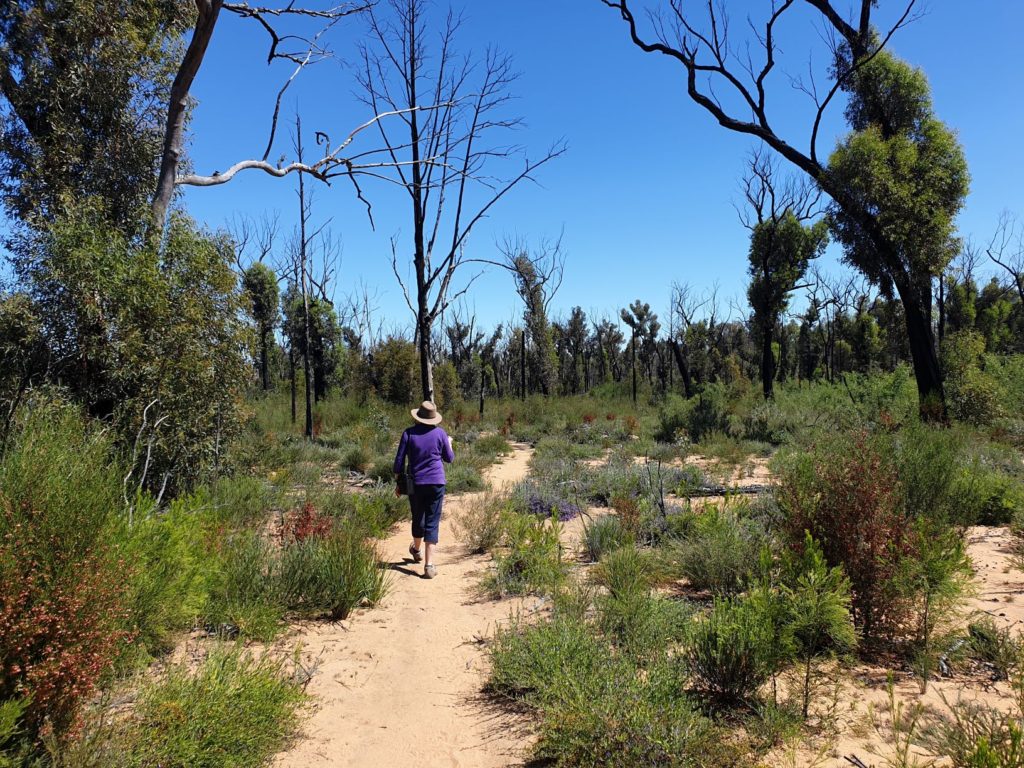
Walking amongst sections of the burned out forest showed the familiar destruction of fire but also the fantastic rejuvenating capabilities of the Aussie bush
In the small country town of Baradine we visited the excellent Pilliga Discovery Centre to learn more about this unique environment, then down to Yarrigan National Park for a picnic lunch. In the afternoon we headed north to drive through Pilliga National Park, our fifth new national park so far on this trip, before finding a beaut little place to camp in the middle of nowhere on the misleadingly named Dog Proof Fence Rd in the Pilliga State Conservation Area. I know, that’s a lot of Pilliga, regardless of how its presented but we reckon we’re experts now.
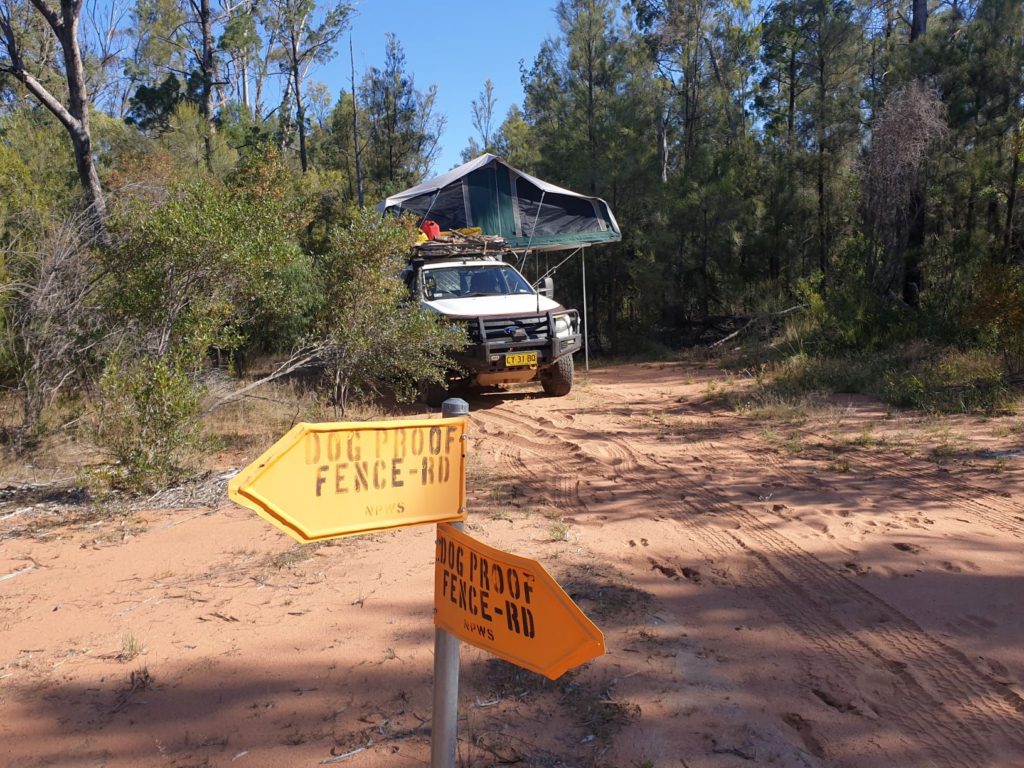
We found a little place to tuck in for the night at the corner of the Dog Proof Fence…which didn’t look like it was up to its name
After another cool night which saw the temps drop to 5C (41F) we headed back to civilization and the regional town of Narrabri where we picked up supplies and fuel. With a little regret and a little more relief we had left the vast Pilliga behind.
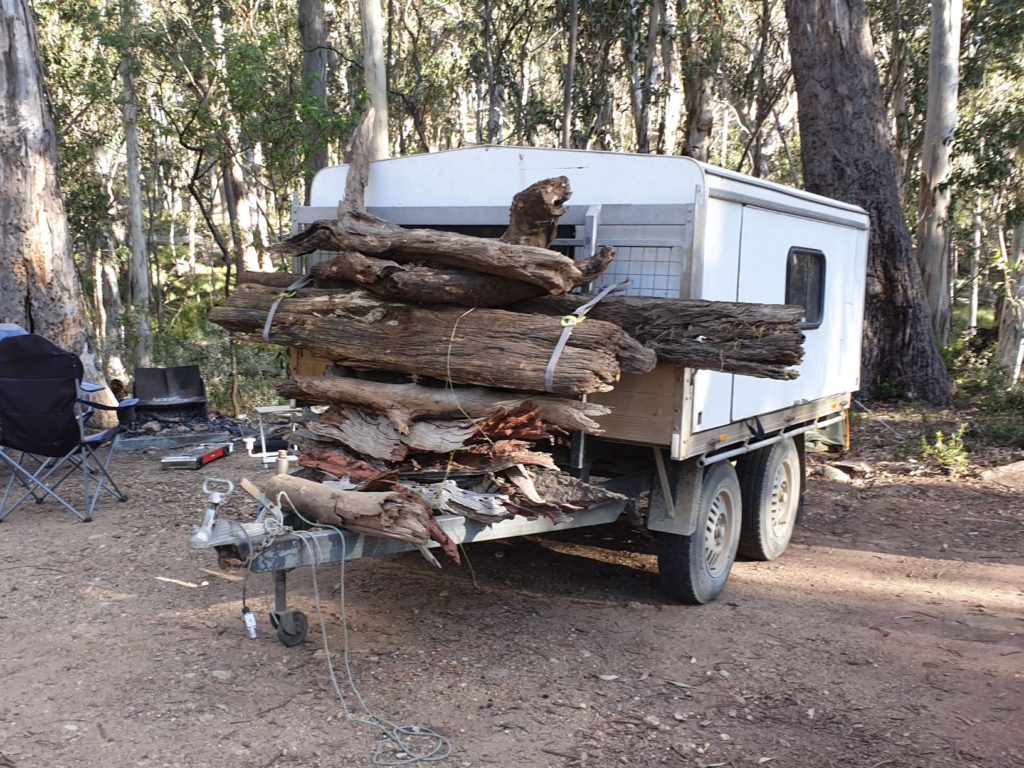
Some people might say I take my fire wood way too seriously…but this guy took firewood to a whole new level
We followed the narrow winding road up into the Nandewar Range of mountains that look like a mistake in the middle of the vast open plains of the Narrabri region. Protecting most of these dramatic mountains is the Mount Kaputar National Park, one of the most popular parks in northern NSW. And we quickly found out why.
The steep road quickly takes you from the hot dusty plains to the high sub-alpine forests where both plants and animals differ from those down below. Amazingly, there is a narrow track up to the top of Mt. Kaputar so we easily summited the 1510m (4,950 feet) peak, a true giant in this part of the state and one of the country’s highest points outside the Snowy Mountain area. The cool mountain air was invigorating and the views stretched as far as the sun glare would allow, just wonderful.
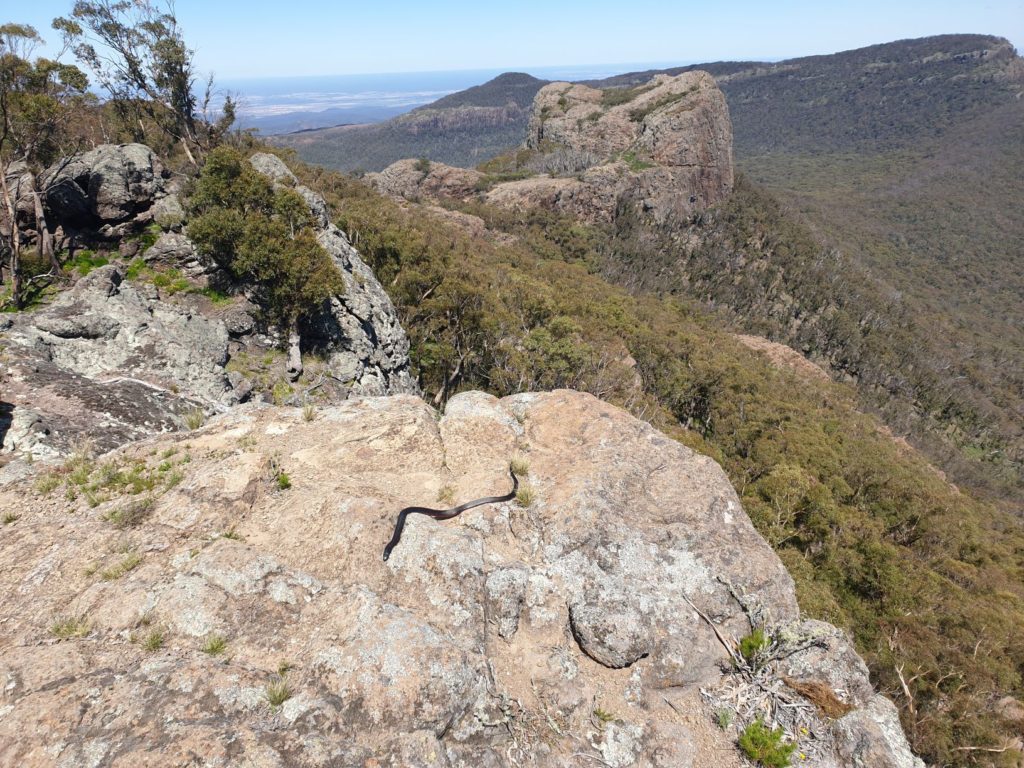
This spectacular view from the Governors Lookout had the special bonus of a red belly black snake slithering across the rock at our feet
We also did a lovely five kilometre walk amongst the various gums that thrive at this altitude, many of them damaged by recent fires, fabulous views looking off the escarpment as the sun set lower, before setting up camp at a campsite called Dawsons Spring and enjoying a cool but invigorating evening around the fire and amongst the gums.
But our northerly sojourn still had more to offer so we continued our trek up the map towards the forbidden Queensland border, driving through some of the prettiest rolling grazing land we had ever seen. This is another planet for most Sydneysiders but we loved the narrow roads, isolated farm lands and remote feeling as we passed through Bingara, Warialda and Coolatai. The first two communities in particular have shown a great deal of pride in keeping their modest country towns trimmed, tidy and very attractive.
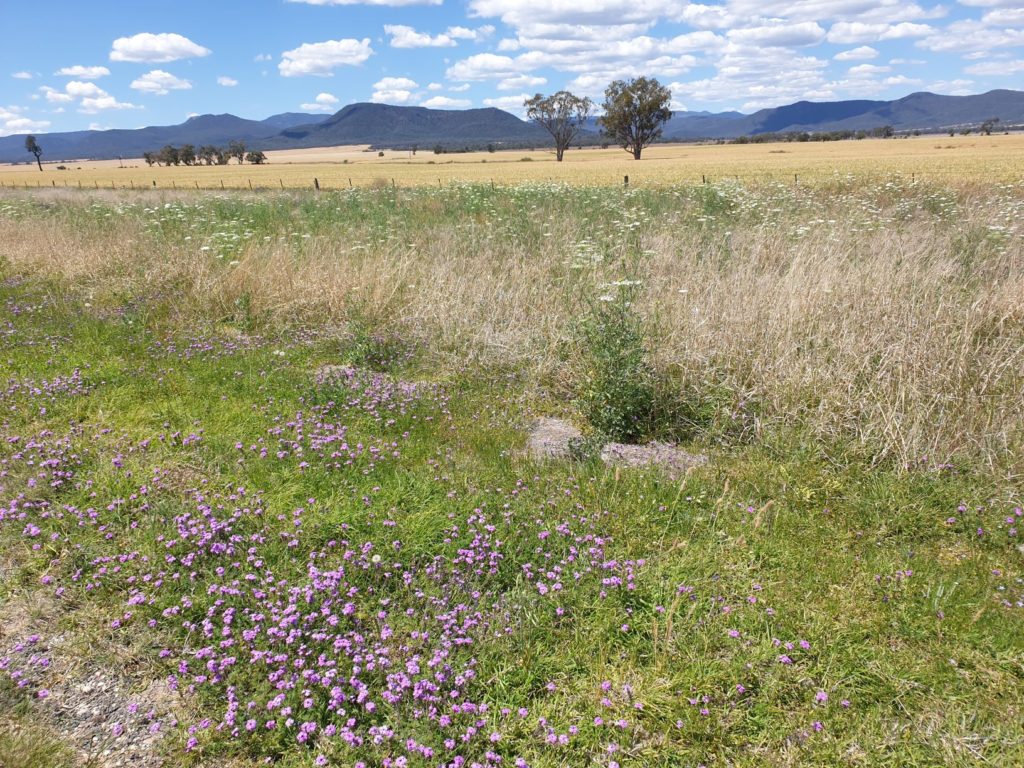
More beautiful rural scenes as we continued our northerly journey – what a fabulous place to call home
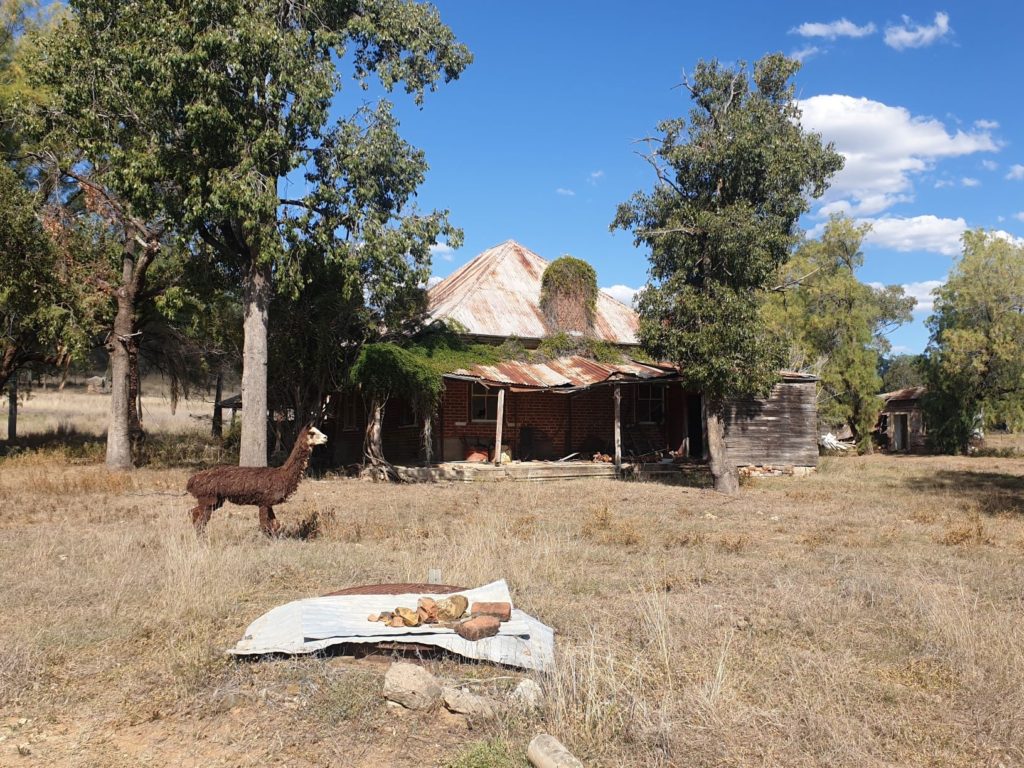
An old deserted farm house is still called home by this random alpaca…not sure what the whole story is here
We ended the day camping by ourselves on the banks of the Severn River in Kwiambal National Park, a million miles from civilization, the corona virus far behind us, no reason for any stress or worries. Just like we like it. Kwiambal NP celebrates and protects the wild country along the Severn and Mcintyre Rivers, including where they finally converge. It is a remote paradise for those who seek it, particularly the Mcintyre Falls and adjoining walks overlooking the dramatic canyons that the two rivers have forged. Around the camp that night the boisterous bird life was fabulous and the reflections on the still river were almost perfect.
And this ended the first leg of our lap around New South Wales – we’ve run out of accessible roads to the north and tomorrow will turn Wanda westward towards the Australian outback. Can’t wait!
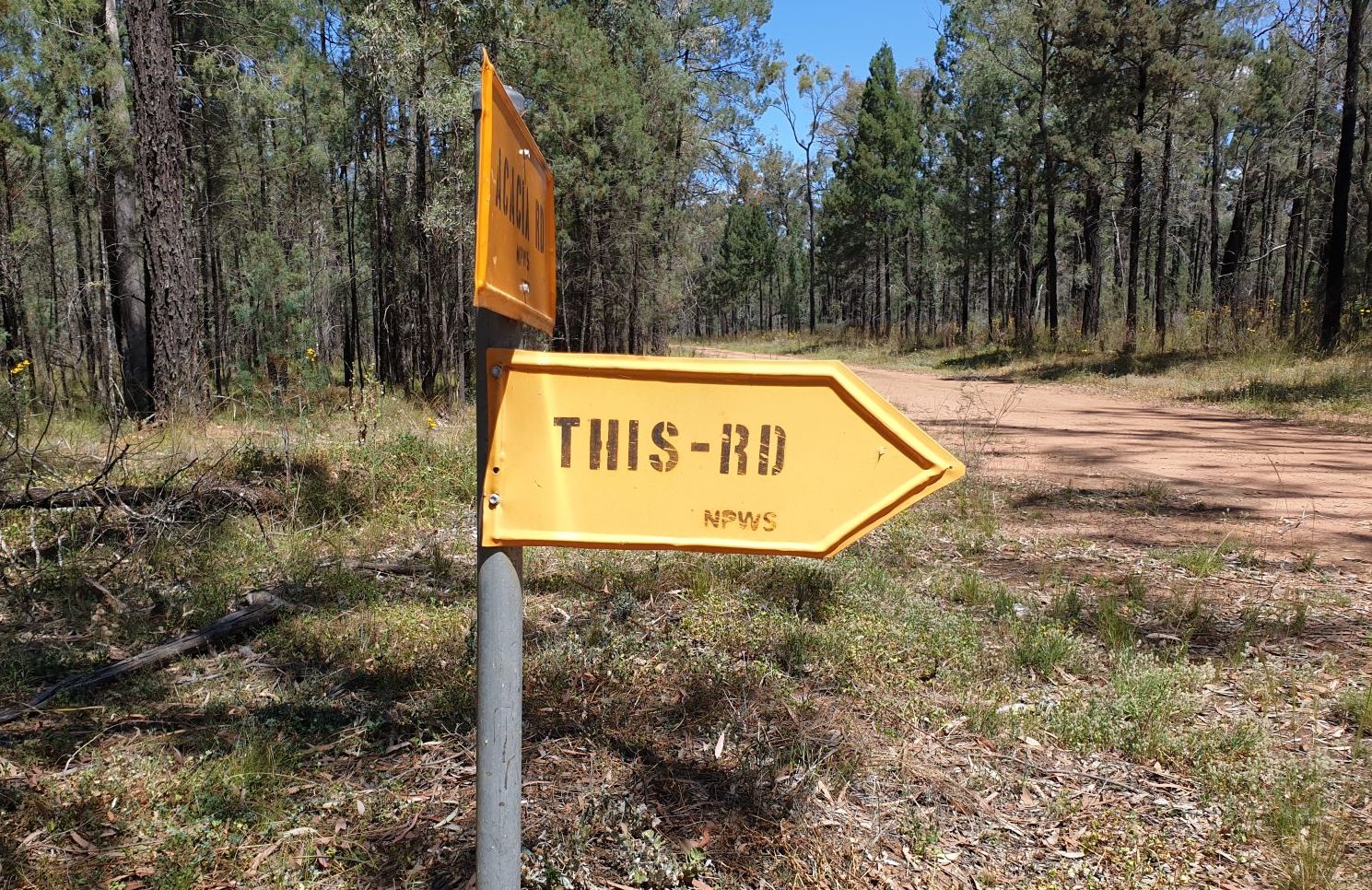
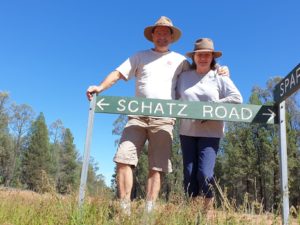
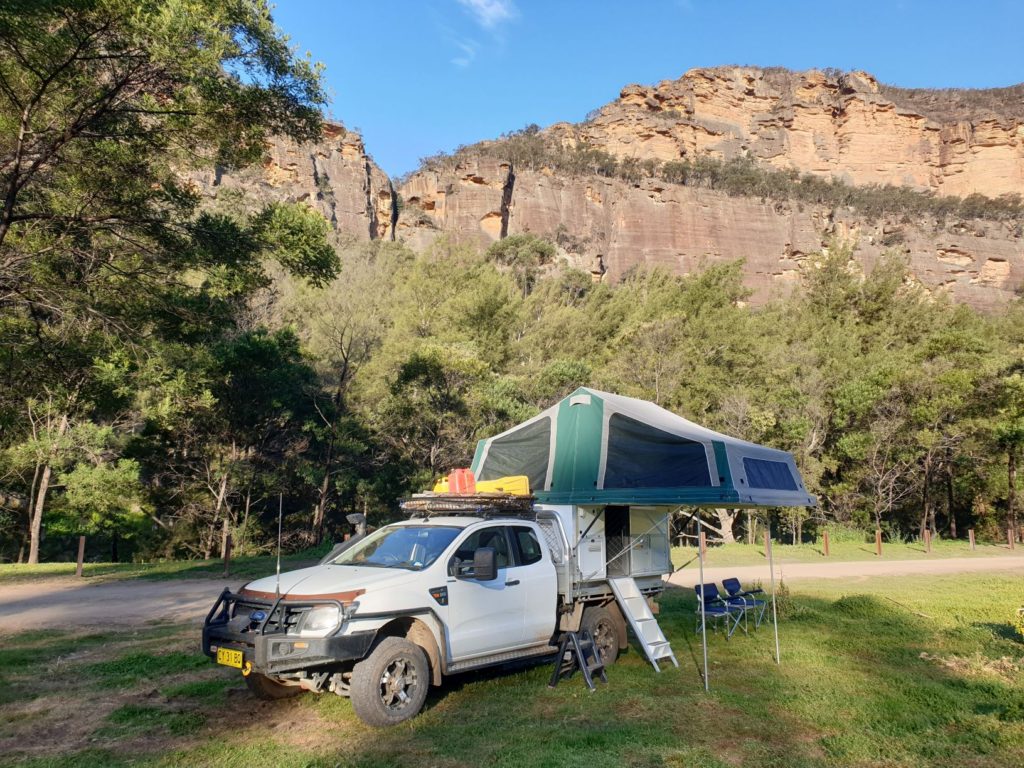
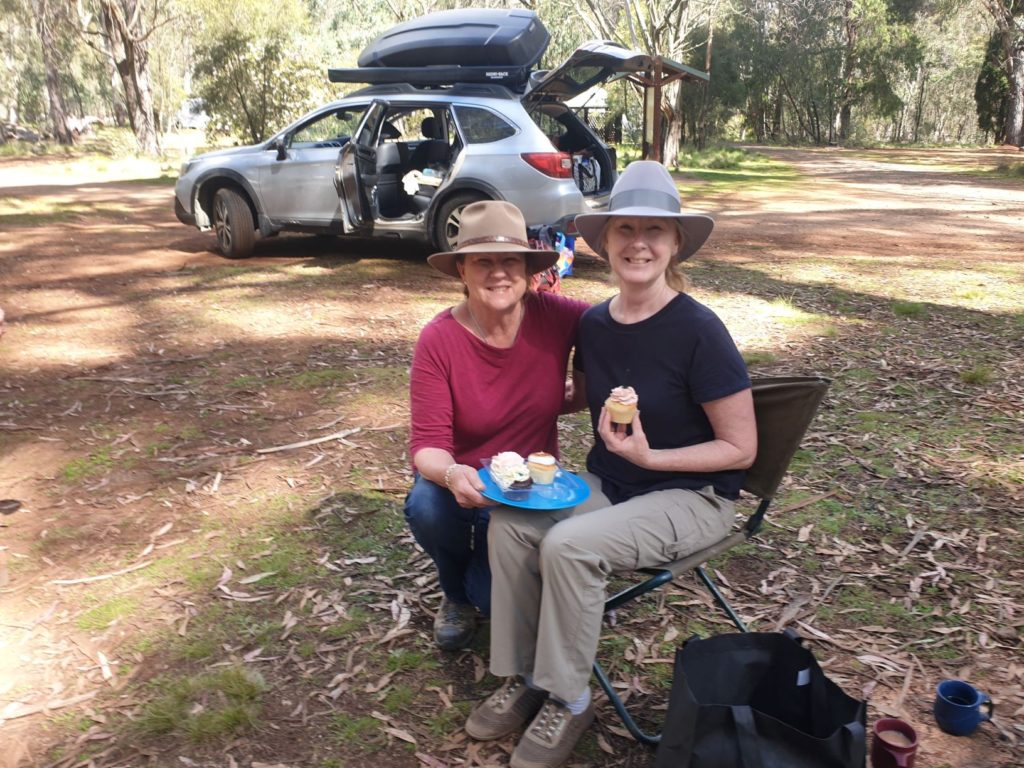
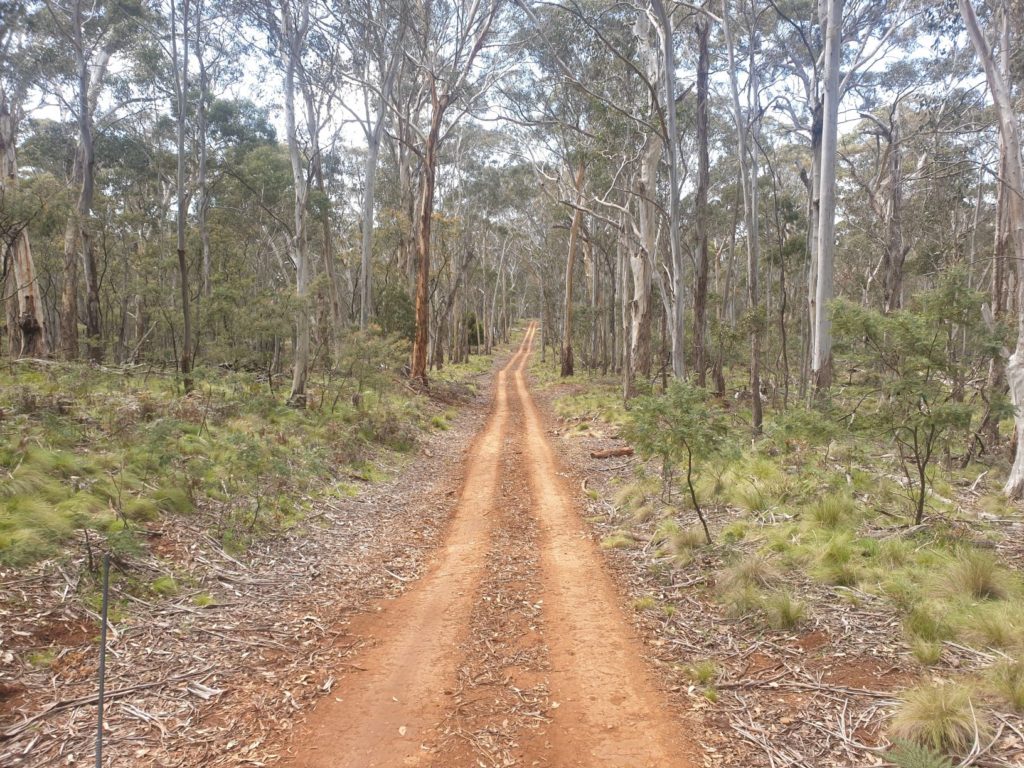
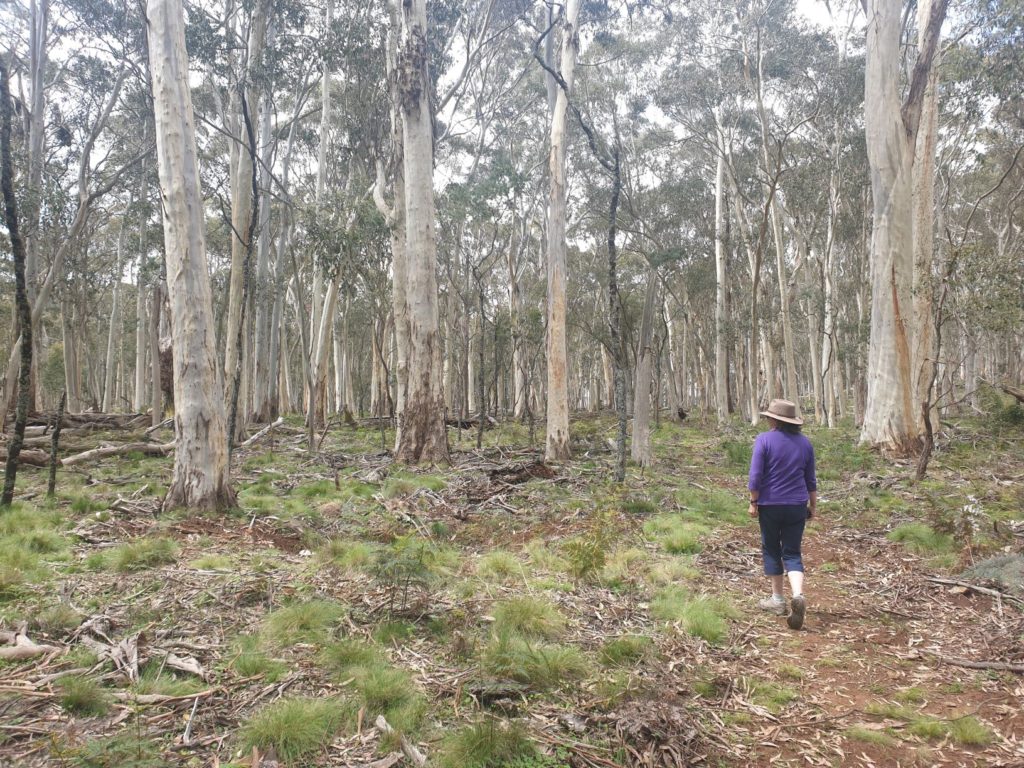
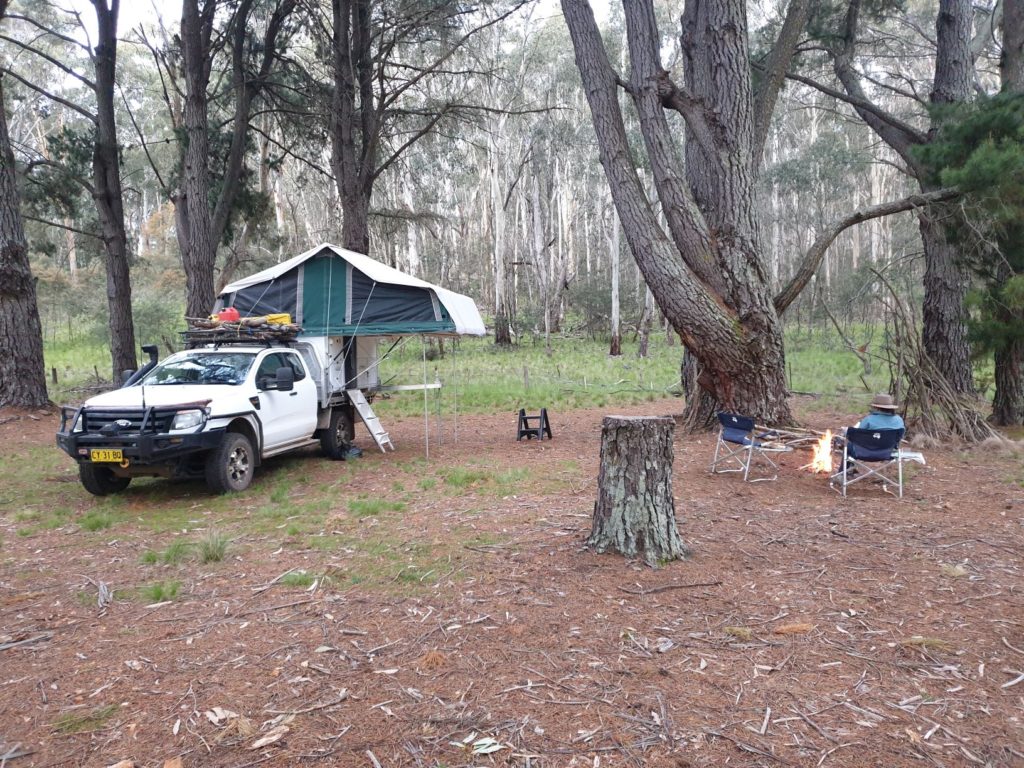
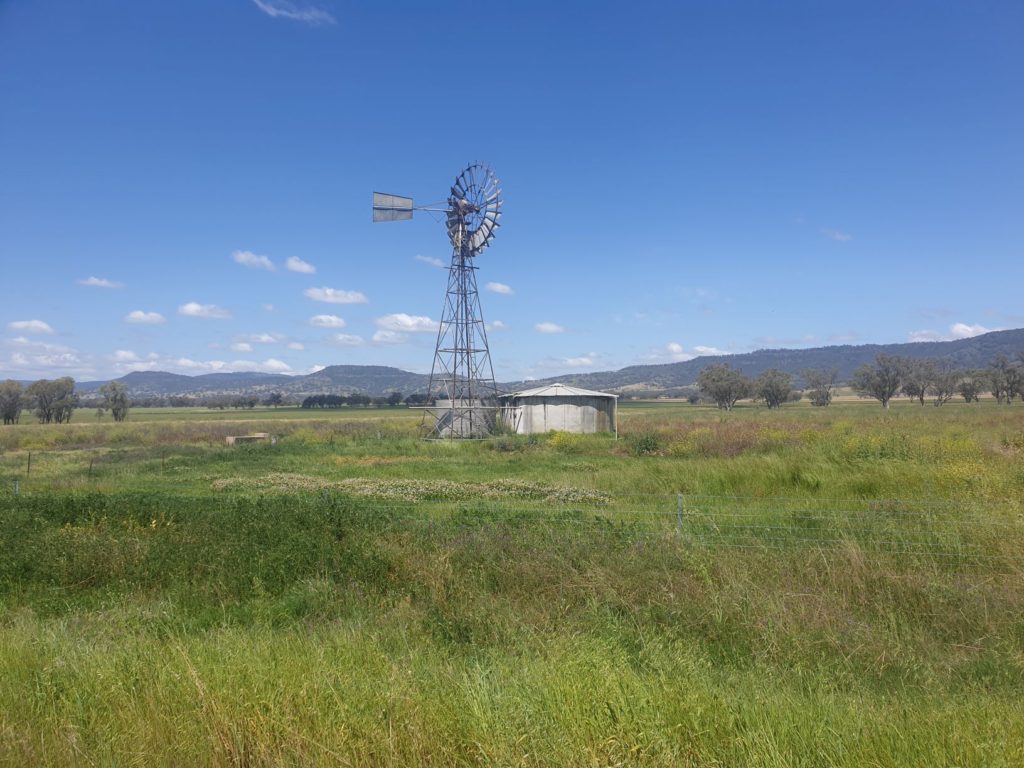
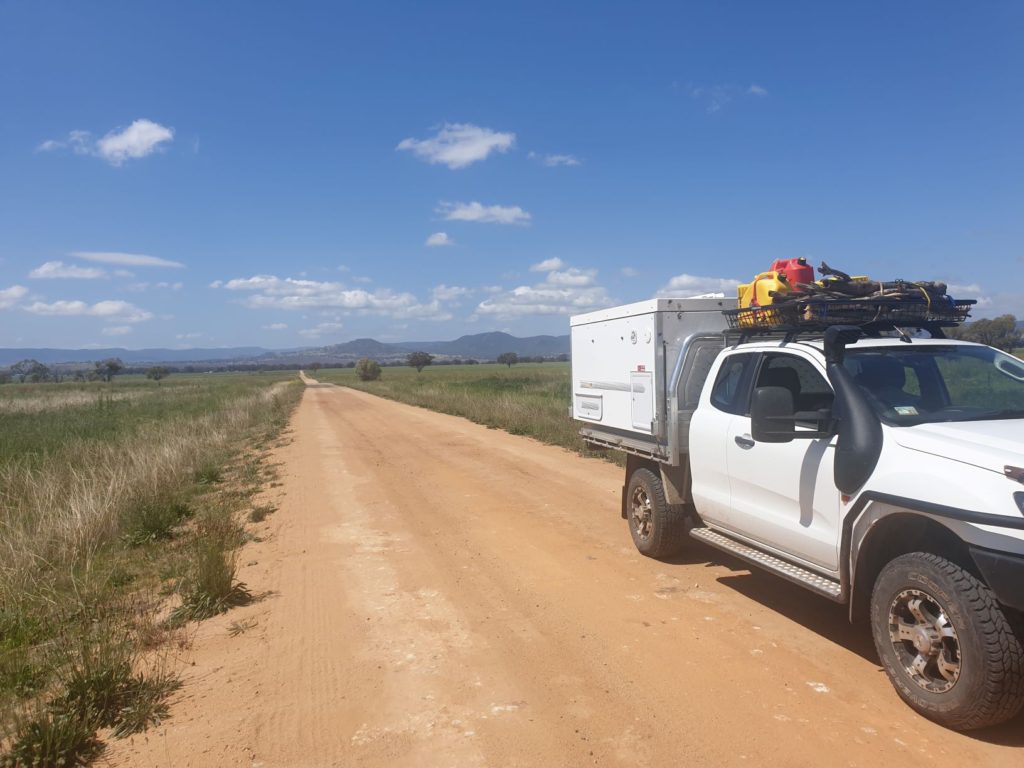
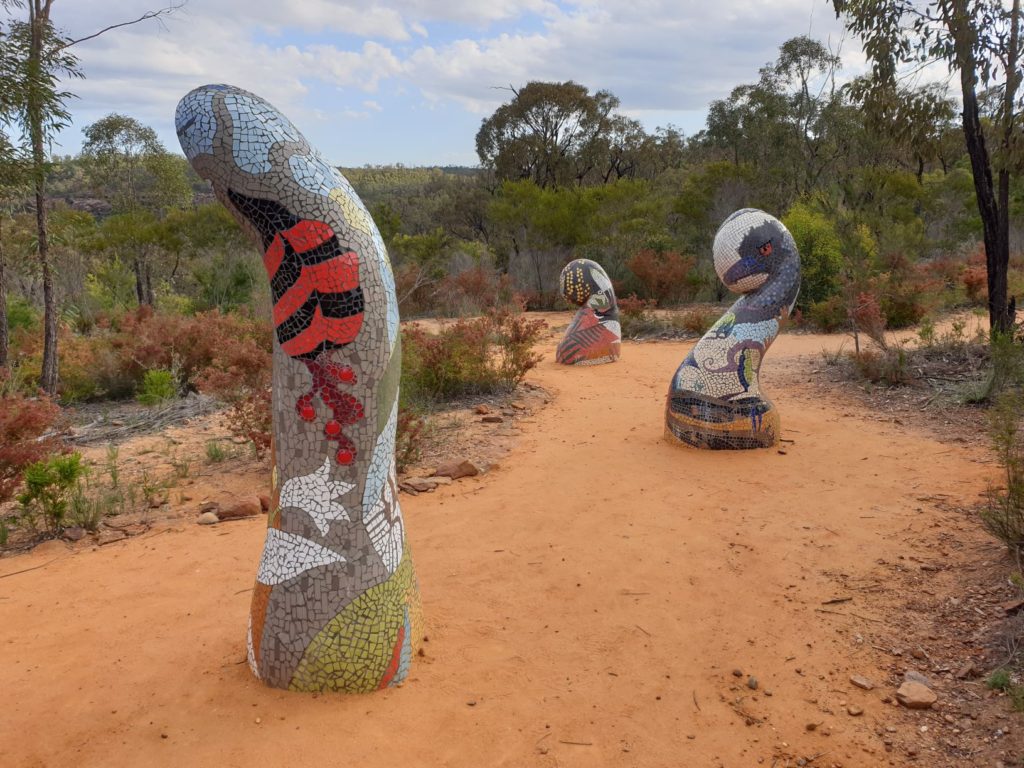
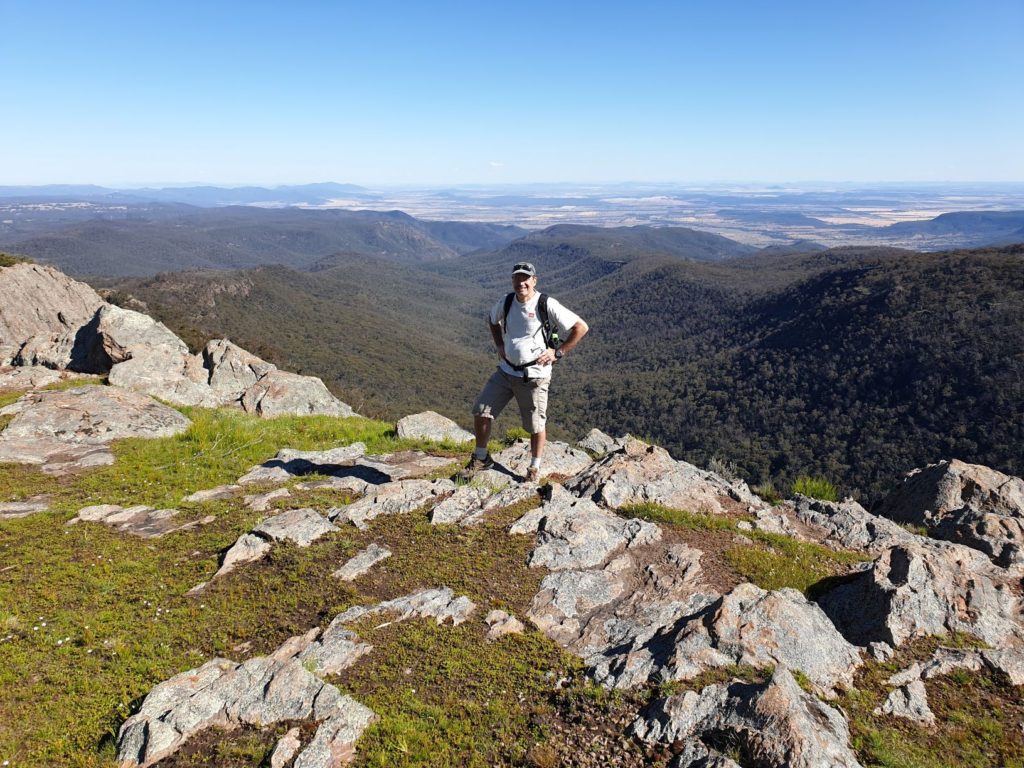
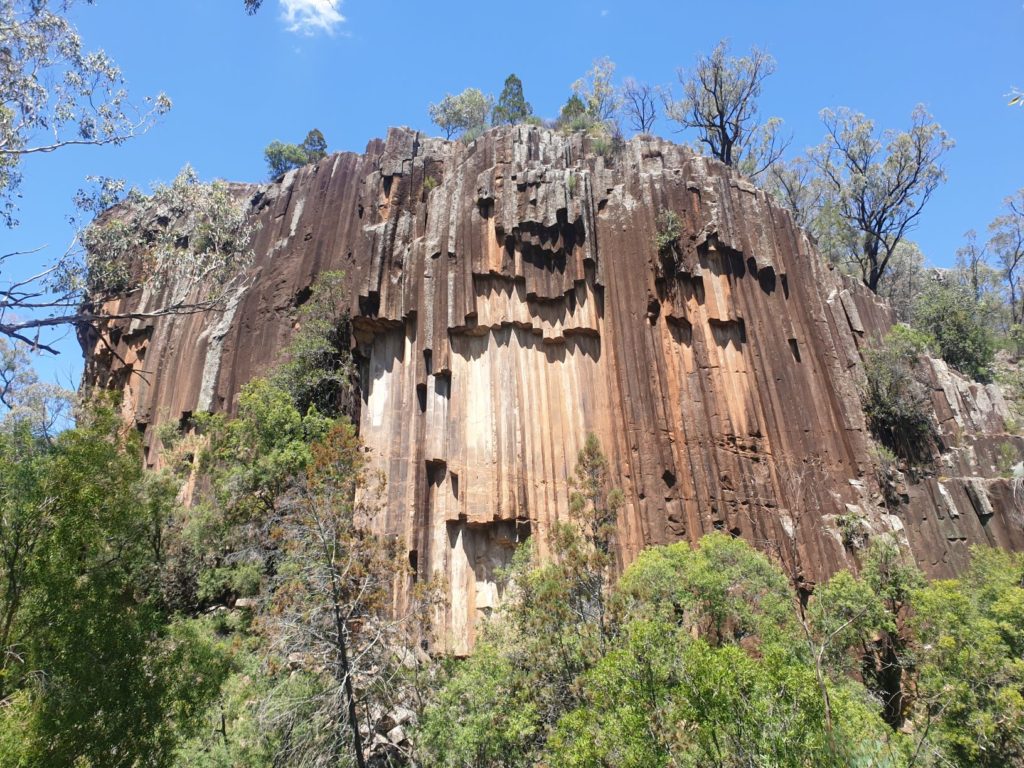
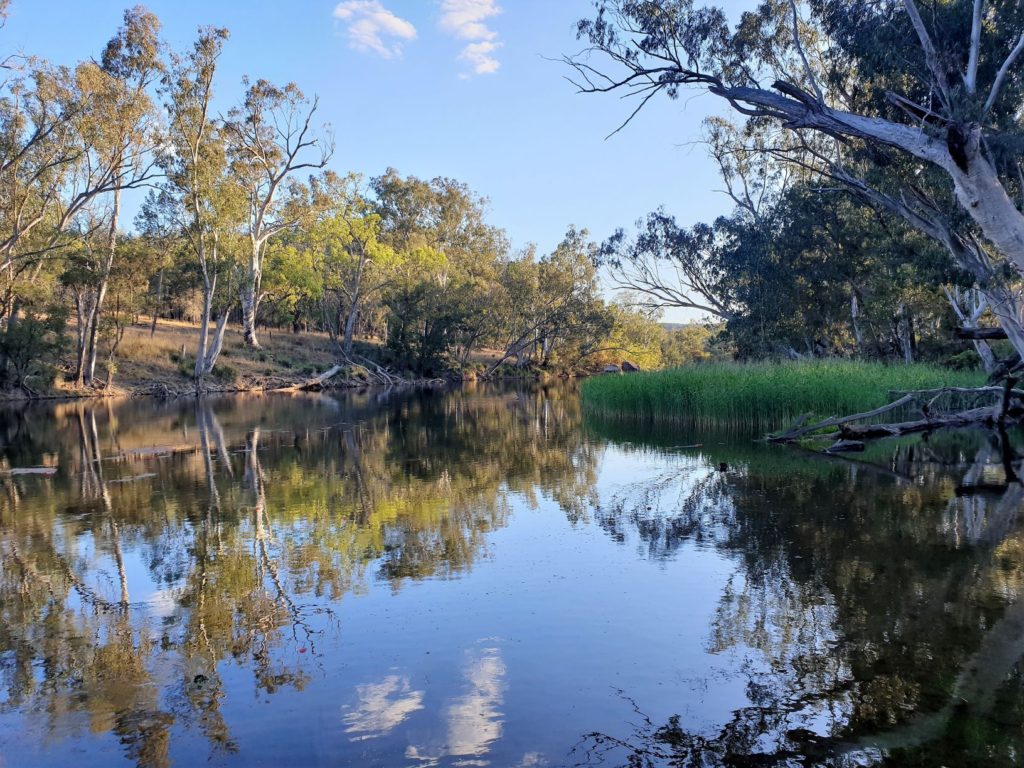
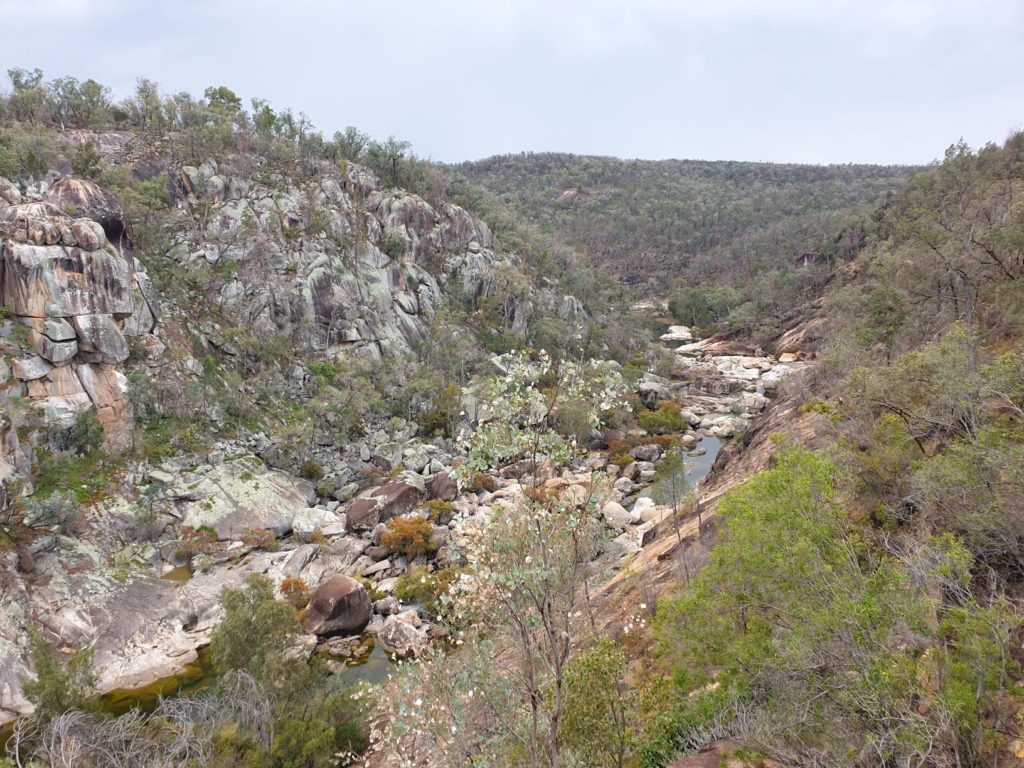
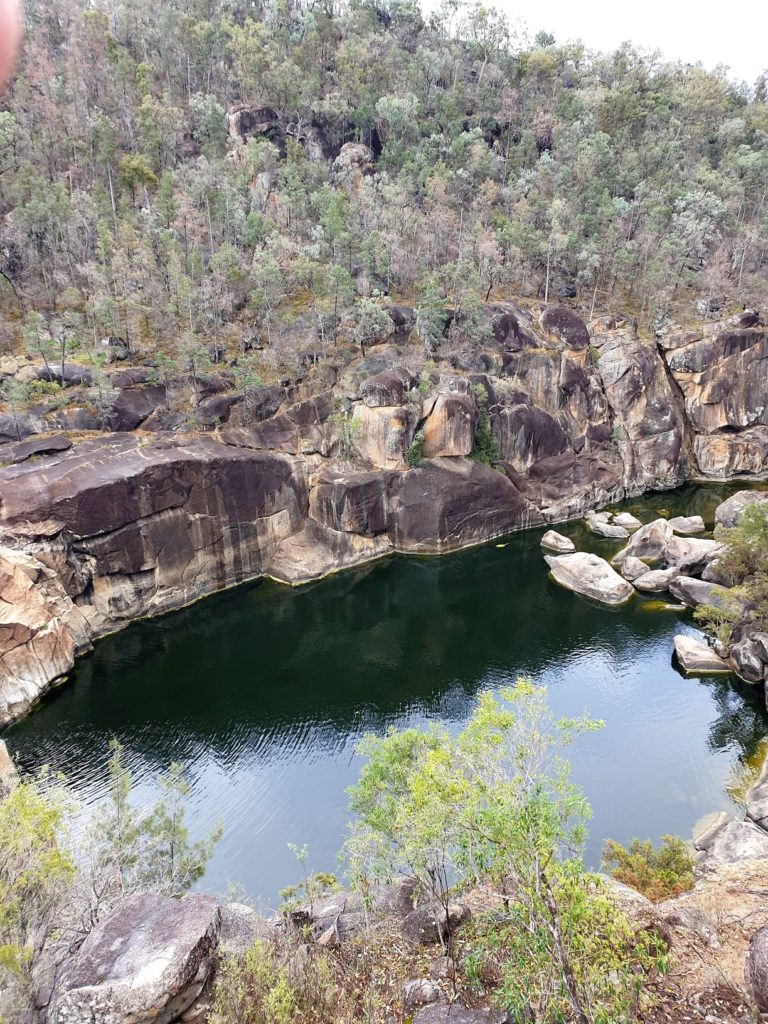
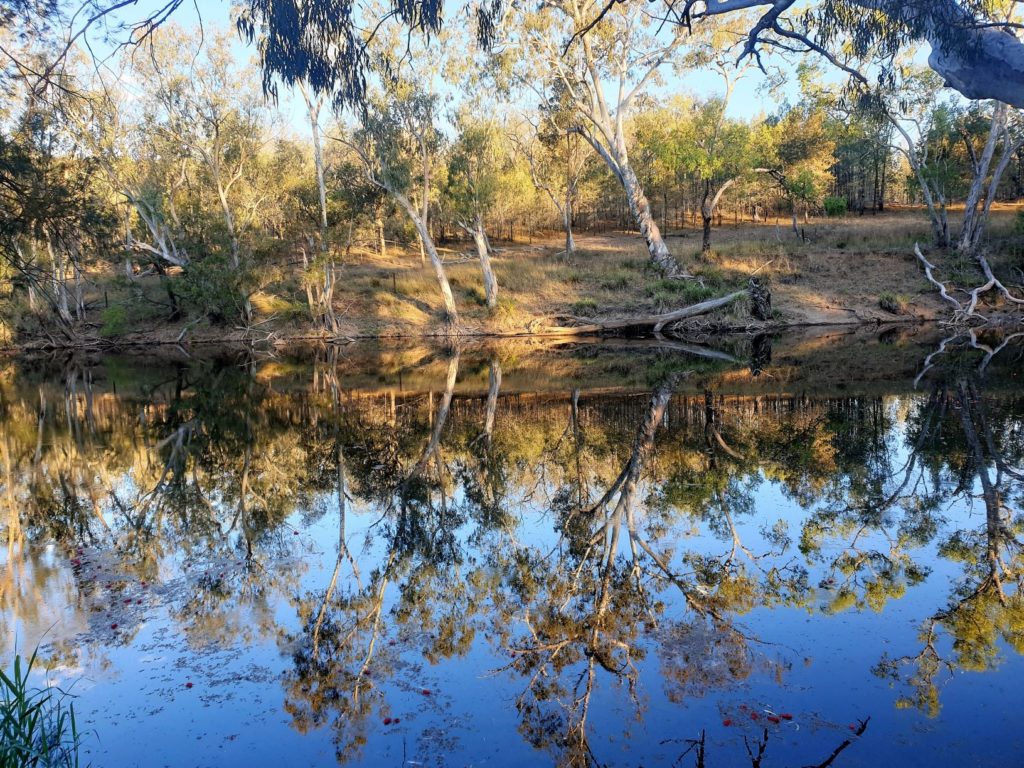
Goodness. What beautiful photos from an area I know nothing about. Thanks for sharing it with us.
Hi Tracy, yes we’ve learned there are many beautiful places near home…you don’t have to go to far away places to see wonderful places. Cheers, Bill
You are enjoying so much of Australia that brings back memories of my mum and dad. They were intrepid bushwalkers and met in a National Park. Their whole lives were spent travelling at any occasion they could spare. Dad was one of the instigators of the NPWS and his descriptions of our country sounded a little like yours.
Thanks for the memories and enjoy your travels. I look forward to your next instalment.
Lots of love to you both, and safe travels.
Xoxo
Thank you for the kind comments Anne, much appreciated. What we’ve learned this year is that you don’t have to go overseas to see amazing places – in fact, there’s an endless supply right here in NSW.
Stay safe,
Bill